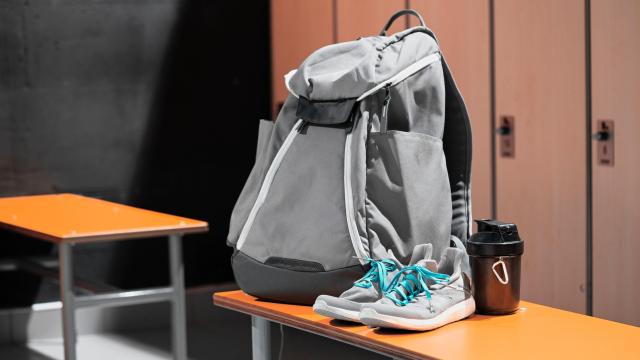Packing for the gym is a bit like packing for a trip: You need to have all the supplies you’ll need for your destination, and you also need everything to be organised so you can find it at the right time. And just to keep things fun, you have to have a plan for dealing with contents that will often be wet and smelly.
Here are some tips for choosing and packing your gym bag so that your trip goes seamlessly, and nothing is smellier or harder to find than it needs to be.
Consider the straps
How will you carry your gym bag? I’m usually toting a bag from the car to the gym and back, so I like a duffel style that I can hold by hand. My bag has a cross-body strap that I can attach in a pinch, but I generally prefer not to.
On the other hand, if you have a walk or bus ride to navigate, backpacks make more sense. Don’t forget to think about what else you’ll be carrying — for example, if you ride the subway to both work and the gym. One backpack and one handheld or cross-body bag can play well together. It’s up to you which you use for the gym and which is for your work things. You could also consider a larger backpack-style bag with dedicated compartments for each function.
Shoe tunnel or no shoe tunnel?
If you only need to carry a few things, a one-compartment bag might do just fine. But if you need more than just a water bottle and a towel, you need to start thinking about organisation and containment.
My bag always contains a pair of weightlifting shoes, and those need to be separate from everything else so that I don’t get floor dirt or foot stink onto the rest of my stuff. Many bags contain a waterproof, tunnel-shaped compartment that you load from the outside, and it’s arguably perfect for shoes.
I don’t like the shoe tunnel, though. I want my shoes to be able to breathe — to help get rid of that stink — so I prefer a compartment with a mesh panel. (My bag is an Adidas Defender, which has one mesh pocket on the outside and one with no mesh.)
The shoe tunnel can also double as a wet bag, though, which is essential if you swim or if you know you’ll end up with wet or particularly dirty clothes. Just remember to empty it as soon as you get home.
How to pack smarter
However many compartments your bag has, you’ll need to make sure you can access the right things at the right time. I recommend splitting up the things you need into categories, and packing each category by itself:
- Things you’ll need before you start working out, like your workout clothes
- Things you’ll need during the workout, like your belt and water bottle
- Things you’ll need afterward, like your towel and shower supplies
- Things you probably won’t need, but you pack just in case — like a first-aid kit or spare granola bar.
You’re not limited by your bag’s built-in compartments, though. Think like a traveller, and use extra organisers like shoe bags and packing cubes.
If I’m heading to a meet where I’ll need a lot of things and be there all day, I have my usual stuff, plus a lunchbox full of snacks, a shoe bag with an extra pair of shoes, and a drawstring bag that contains every type of strap, wrap, and glove I might end up needing during the day. Many of these things are duplicates or backups that I don’t normally carry. By confining them to their own bag, I can easily find all my usual things in their usual place, and still know where to get the extras.
Unpack it when you get home
The most important part of gym bag maintenance, besides going through it every now and then to pull out the stuff you don’t actually need, is to open it up every time you get home:
- Open up that protein shaker and immediately wash it, or at least toss it in the sink. (If you were smart, you rinsed it out while you were still at the gym.)
- Put any wet or dirty clothes in the laundry.
- Air out anything that got sweaty but won’t be washed, like your knee sleeves and your shoes. Loosen the laces and pull the tongues out, and set them on or next to your bag so you won’t forget them when you re-pack.
This process only takes a few minutes, and it does so much to ensure that your bag won’t fester in its own stench. When I played roller derby, my skate bag was a rolling suitcase, and I had a little place in the basement to store it. Every day when I’d come home from practice, I would unzip the suitcase and hang each individual kneepad and elbow pad on a set of hooks that I’d installed for that purpose.
When it’s time to go back to the gym, reverse the process — again, it’s just a few minutes — and make sure you have everything you need.

Leave a Reply
You must be logged in to post a comment.